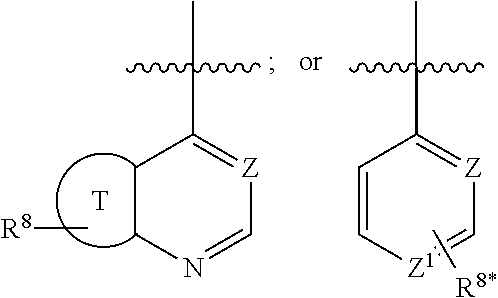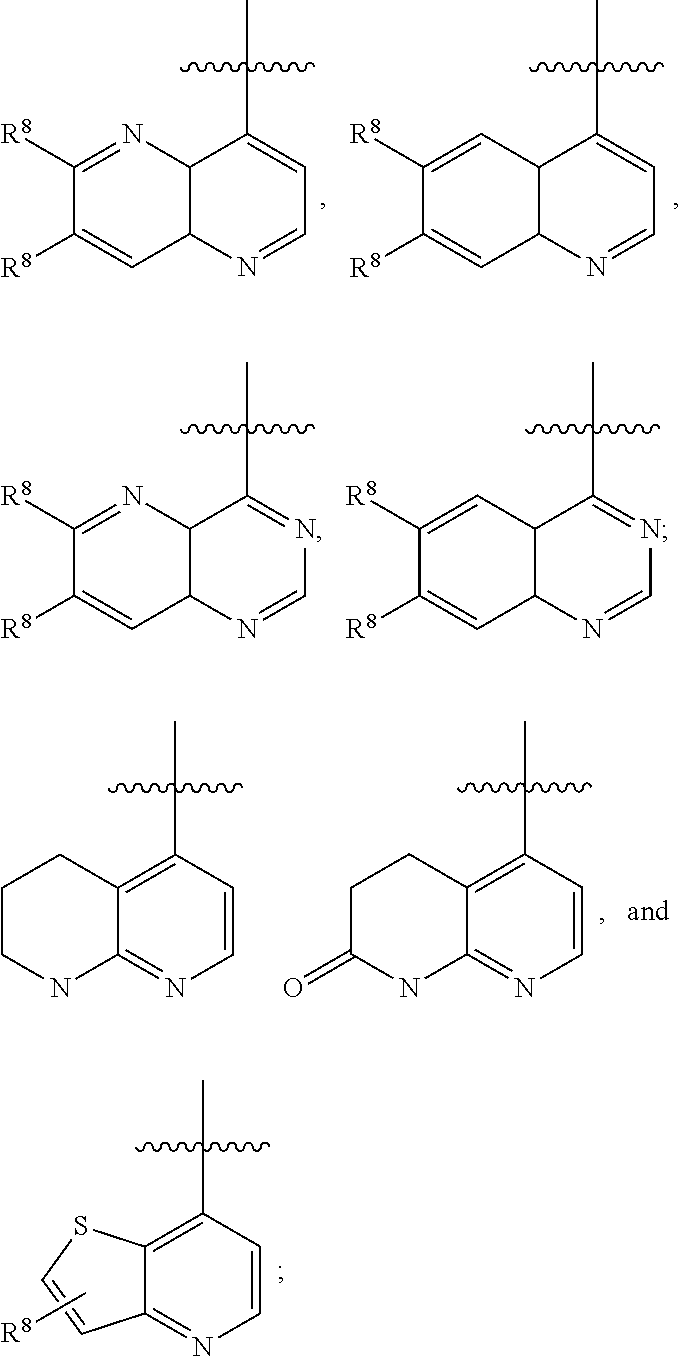Substituted amide derivatives and methods of use
a technology of substituted amide and derivatives, applied in the field of substituted amide derivatives, can solve the problems of fibrosis, aberrant stromal proliferation, and excessive matrix deposition
- Summary
- Abstract
- Description
- Claims
- Application Information
AI Technical Summary
Benefits of technology
Problems solved by technology
Method used
Image
Examples
example 1
[0784]
[0785]Step 1: 1-methyl-2-phenyl-5-(pyridin-4-yl)-1,2-dihydropyrazol-3-one. thyl isonicotinoylacetate (3.01 g, 16 mmol) and 1-methyl-2-phenylhydrazine (2.03 g, 17 mmol) were suspended in water (50 ml) and glacial acetic acid (1.35 ml, 23 mmol) was added. The flask was fitted with a reflux condenser and placed in a preheated oil bath (115 C) and stirred. After 4 hours, the reaction cooled to room temperature and extracted with EtOAc (2×100 ml; 50 ml), 10:1 DCM / MeOH (110 ml), and EtOAc again. The organic phases were combined, dried over sodium sulfate, filtered, and concentrated. The crude material was purified on silica gel (DCM->20:1->10:1 DCM / MeOH->10:1->4:1 DCM / 2 N ammonia in MeOH). Fractions with product collected, concentrated, and repurified on silica gel using DCM->20:1 DCM / MeOH->5:1 DCM / 2 N ammonia in MeOH). The fractions with product were collected and concentrated to give 1-methyl-2-phenyl-5-(pyridin-4-yl)-1,2-dihydropyrazol-3-one (3.31 g, 70% purity, 9.2 mmol, 59%). M...
example 2
[0789]
[0790]Step 1: Methyl 1,5-dimethyl-3-oxo-2-phenyl-2,3-dihydro-1H-pyrazole-4-carboxylate. 2,3-dimethyl-5-oxo-1-phenyl-2,5-dihydro-1H-pyrazole-4-carboxylic acid (7.55 g, 33 mmol) was dissolved in dichlormethane (145 ml) and oxalyl chloride (4.1 ml, 46 mmol) was added via syringe over about 10 minutes, resulting in vigorous bubbling. After stirring at room temperature for about 30 minutes, the reaction was cautiously quenched with MeOH (100 ml). The methanol was added slowly at first as vigorous gas evolution was observed. The reaction was stirred at room temperature for 1 hour, concentrated, and then partitioned between dichlormethane (125 ml) and saturated sodium bicarbonate (125 ml). More dichlormethane and saturated sodium bicarbonate were added, and the layers of the biphasic, homogeneous solution were separated. The aqueous phase was extracted with dichlormethane (3×100 ml), and the organic phases were collected, dried over sodium sulfate, filtered, and concentrated to give ...
example 3
[0795]
[0796]N-(4-(6,7-dimethoxyquinolin-4-yloxy)-3-fluorophenyl)-5-((ethyl(methyl)amino)methyl)-1-methyl-3-oxo-2-phenyl-2,3-dihydro-1H-pyrazole-4-carboxamide: MS (ESI pos. ion) m / z 586 (MH+) Calc'd exact mass for C32H32FN5O5 585. 1H NMR (300 MHz, CDCl3) 11.08 (s, 1H). 8.49 (d, J=5.26 Hz, 1H) 7.93 (d, =12.42 Hz, 1H); 7.68-7.25 (m, 8H), 7.18 (t, J=17.25 Hz, 1H) 6.43 (d, =6.14 Hz, 1H) 4.21 (s, 2H) 4.06 (s, 3H) 3.57 (s, 3H) 2.62 (q, J=7.16 Hz, 2H) 2.36 (s, 3H) 1.14 (t, =7.09 Hz, 3H).
PUM
 Login to View More
Login to View More Abstract
Description
Claims
Application Information
 Login to View More
Login to View More - R&D
- Intellectual Property
- Life Sciences
- Materials
- Tech Scout
- Unparalleled Data Quality
- Higher Quality Content
- 60% Fewer Hallucinations
Browse by: Latest US Patents, China's latest patents, Technical Efficacy Thesaurus, Application Domain, Technology Topic, Popular Technical Reports.
© 2025 PatSnap. All rights reserved.Legal|Privacy policy|Modern Slavery Act Transparency Statement|Sitemap|About US| Contact US: help@patsnap.com



